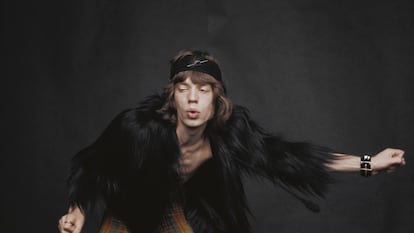Mick Jagger turns 80: The story of the rock legend’s most memorable performance
Today, July 26, the renowned Rolling Stones vocalist enters his eighth decade on earth. We take a look back at one of the band’s most iconic moments. This fall, the group will release its first album of new songs in 18 years
It was half past four in the morning on a December day in 1968. The Rolling Stones had started filming at 8 a.m. the morning before, recording scenes for their Rock and Roll Circus TV show. The band was beyond exhausted, but they had to do one more take of a song they just couldn’t get right. They debated recording it the next day, but decided they had to keep going: there wasn’t the budget for it. Mick Jagger took the helm and huddled the band back together. He asked them to make one last push. Keith Richards, Brian Jones, Charlie Watts and Bill Wyman stood wearily at their instruments, wearing grimaces of displeasure. The conga intro to Sympathy for the Devil began to play. Then, suddenly, the miracle happened. This is how Philip Norman, the author of the most comprehensive biography on Jagger (Mick Jagger, Ecco, 2012) tells it: “Despite his exhaustion, he gave his diabolic Bayeux Tapestry the most extraordinary interpretation it had ever had, or would have, galvanizing his sleepy audience awake in their colored ponchos, daring the temperamental cameras to miss so much as a millisecond, focusing even Brian’s beclouded features into a trance of ecstatic approval. By the end, the ‘mayne of wealth and taste’ had turned into a sacrificial victim, kneeling low before the camera as if for the headman’s ax, then tugging off his red T-shirt to reveal that skinny yet well-muscled physique, tattooed across chest and biceps with black magical faces and designs.” (Incidentally, Jagger’s tattoos were fake).
With the release of Beggars Banquet, the year 1968 was a watershed moment for the British rock group, and the beginning of their best streak, which would continue through the albums Let It Bleed (1969), Sticky Fingers (1971) and Exile on Main St. (1972). Brian Jones was arrested and convicted for drug possession (he paid a fine and was released from jail), one year after Jagger and Richards had been arrested for the same reason. 1968 was also a year of peace, with zero quarrels between Jagger and Richards, who were both 25 at the time.
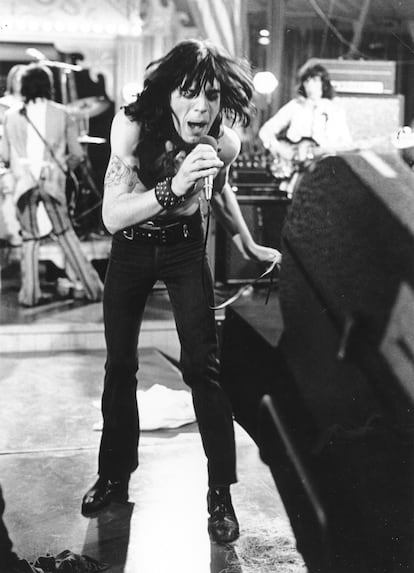
In September of that same year, Jagger and Anita Pallenberg began shooting the film Performance, the ambitious singer’s first starring role. Pallenberg was also Richards’ romantic partner. “I didn’t find out for ages about Mick and Anita, but I smelled it,” Richards writes in his autobiography, Life (Little, Brown and Company, 2010). “It probably put a bigger gap between me and Mick than anything else, but mainly on Mick’s part, not mine. And probably forever.” Later, Richards adds that while Jagger was having an affair with Pallenberg, he was having fun with the singer’s girlfriend, Marianne Faithfull. The history of the Stones: two alpha males competing.
With the tense atmosphere hanging between the two band leaders, Jagger began promoting his own personal project: recording a television program with his favorite fellow rockstars. Filming would take place in December 1968. The singer was so determined to see it through that he financed the project himself: 50,000 pounds out of his own pocket. With Michael Lindsay Hogg, who had already worked with The Beatles, hired to direct, the show would feature a decadent and ragged circus, with dwarves, fire-eaters and face-painted jugglers. And it would be filmed in London. Jagger pulled out his Rolodex: John Lennon would lead a band called The Dirty Mac, with Eric Clapton on guitar, Richards on bass, and Mitch Mitchell of The Jimi Hendrix Experience on drums. The Who were also invited to participate, as was Jethro Tull (with Black Sabbath’s Tony Iommi on guitar), Taj Mahal (at Richards’ express request), and Marianne Faithfull, who led a heavenly performance of the song Something Better. Faithfull, still shaken by her experience, just months earlier, of miscarrying the child she was expecting with Jagger, poured all of her emotions into the song. Yoko Ono would put on her own show. And all of the sets would take place in a circus tent, with Jagger, whip in hand, as the host. There would be about 300 audience members, all wearing brightly colored ponchos, in an atmosphere sprinkled with every psychedelic substance available at the time.
The Rolling Stones rehearsed 10 songs, but only six were ultimately filmed: four of them from their recent Beggars Banquet (Parachute Woman, No Expectations, Salt of The Earth and Sympathy for The Devil), along with You Can’t Always Get What You Want (which they would include on their next album, Let It Bleed) and Jumpin’ Jack Flash (released months earlier). The supreme moment of the set would come with the performance of Sympathy for the Devil, with Jagger transmuting into a divine Lucifer, relentlessly dragging the rest of the band to the utter edge. During the song, he moves, between spasms, as if possessed, and as he sings, the listener feels a strange dual sensation of fear and attraction. The show’s audience, growing increasingly exhausted as the hours went on, would give themselves over to this prince of darkness, who transformed the circus set into a ritual of shamanic transcendence. Pete Townshend can be seen jumping up and down, and John Lennon and Yoko Ono shaking.
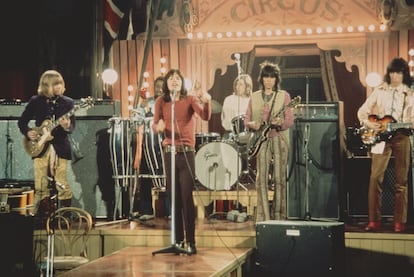
“It was Jagger’s energy that got it going,” remembers singer Ian Anderson, who had performed earlier in the day with his band Jethro Tull. “It was impressive to see him drag the rest of the band with him.” When the recording was finished, Jagger, always tireless, went for a walk with Marianne Faithfull and Taj Mahal along the Thames. The show would be Brian Jones’ last public performance with the Stones. In some clips, the guitarist can be seen collapsing in exhaustion, or barely shaking a pair of maracas. Jones was expelled from the group in June 1969 and one month later, he was found dead in the swimming pool at his house.
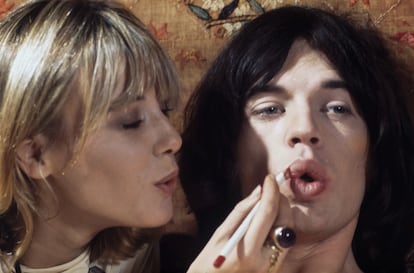
At the time, the most memorable 8 minute and 49 seconds of the day — the group’s now iconic performance of Sympathy for the Devil — paradoxically did not win over the Stone themselves. So much so that they decided to shelve Rock and Roll Circus entirely. The reason? The group thought that The Who’s performance, which was undeniably devastating, would overshadow everything else. It took 28 years before the band would decide to release Rock and Roll Circus, in 1996. After recording the program, Jagger and Richards went on a cruise to Brazil with their respective partners, Marianne Faithfull and Anita Pallenberg — all of them seeing the specter of infidelity just around the corner, and some of them (especially Anita and Keith) with the shadow of hard drugs beginning to darken their skies.
The purpose of the trip to Brazil was to mend the relationship between the two band leaders, and to keep the flame of songwriting alive. According to Laura Jackson’s account in her book Insatiable: The Secret Life of Mick Jagger (John Blake Publishing, 1999), Jagger continued to flirt with Pallenberg during their vacation, and Anita would later comment that the singer’s main interest in doing so was specifically to annoy Richards. In spite of their quarrels, the two musicians would join forces to spearhead what would become the band’s greatest period of songwriting yet.
More than 50 years later, and with Jagger now in his 80s and Richards about to turn 80 as well, on December 18, one of rock’s most iconic duos is still able to sit down together and write songs: their new album, the first record to feature new, original tracks in 18 years, will be released this fall.
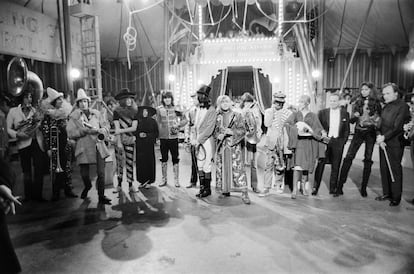
Sign up for our weekly newsletter to get more English-language news coverage from EL PAÍS USA Edition
Tu suscripción se está usando en otro dispositivo
¿Quieres añadir otro usuario a tu suscripción?
Si continúas leyendo en este dispositivo, no se podrá leer en el otro.
FlechaTu suscripción se está usando en otro dispositivo y solo puedes acceder a EL PAÍS desde un dispositivo a la vez.
Si quieres compartir tu cuenta, cambia tu suscripción a la modalidad Premium, así podrás añadir otro usuario. Cada uno accederá con su propia cuenta de email, lo que os permitirá personalizar vuestra experiencia en EL PAÍS.
¿Tienes una suscripción de empresa? Accede aquí para contratar más cuentas.
En el caso de no saber quién está usando tu cuenta, te recomendamos cambiar tu contraseña aquí.
Si decides continuar compartiendo tu cuenta, este mensaje se mostrará en tu dispositivo y en el de la otra persona que está usando tu cuenta de forma indefinida, afectando a tu experiencia de lectura. Puedes consultar aquí los términos y condiciones de la suscripción digital.
More information
Archived In
Últimas noticias
Most viewed
- David King, chemist: ‘There are scientists studying how to cool the planet; nobody should stop these experiments from happening’
- Reinhard Genzel, Nobel laureate in physics: ‘One-minute videos will never give you the truth’
- Mexico completes its trade shift with the entry into force of tariffs on China and countries without trade agreements
- Oona Chaplin: ‘I told James Cameron that I was living in a treehouse and starting a permaculture project with a friend’
- Sinaloa Cartel war is taking its toll on Los Chapitos
